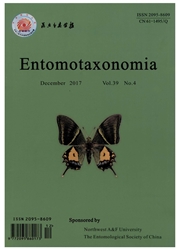

 中文摘要:
中文摘要:
采用扫描电镜、红外光谱、气相色谱/质谱联用技术研究了柑橘真棉蚧Eupulvinaria citricola(Kuwana)(半翅目:蚧科)蜡泌物的超微形态、红外光谱和卵囊蜡质的化学成分特征。结果发现:该蚧雌虫背面腺体分泌湿蜡,在体表面形成溥的半透明蜡壳,背面蜡壳分为6个小区,表面由湿蜡凝结成片状和蜡块状构造。雌成虫产卵期由腹面多格腺分泌丝状蜡结成卵囊。雄若虫也分泌湿蜡,雄蛹的蜡茧薄,表面有浅的凹凸花纹。用雌成虫卵囊、背面蜡壳和雄茧的蜡质作红外光谱分析。它们的谱图具有共同的基本特征,吸收峰群分为5个区域:2900cm^-1附近的3个强吸收峰组成的峰群是〉CH2和-CH,的特征吸收峰;1800cm^-1~1500cm^-1之间的吸收峰群是羰基(〉C=O)和C=C键的伸缩振动:1500cm^-1,1400cm^-1区域是〉CH2和-CH3基团的吸收峰:1400cm^-1-1000cm^-1之间为饱和碳链-C~C-C-骨架振动。730cm^-1附近为环状化合物的基团吸收峰群。由此确定它们的组成都是长碳链结构的脂肪酸、脂肪醇、烃类、酯类或带有环状结构的化合物。其主要区别在第2、3、4区吸收峰的形式、强度和数量,反映出基团的种类和数量不同。雌成虫卵囊蜡质甲酯化后GC,MS检测出7个组分(表1),全部为长链脂肪酸。未经甲酯化的蜡质检测出4类16个组分(表2),可分为长链烃、酸、醇、酯。第一类为饱和长链烃,5个组分,占总组分的38.38%;第二类是长链脂肪酸。包括直链饱和酸和不饱和酸共6个组分,占31.59%:第三类是直链饱和醇,占2.87%:第四类是酯类化合物,4个组分,占总组分的27.16%。
 英文摘要:
英文摘要:
The ultra-morphology, infrared spectra characteristics and chemical composition of the waxes secreted by the scale insect Eupulvinaria citricola (Kuwana) (Hemiptera: Coccidae) was studied using scanning electron microscope (SEM), infrared absorption spectra (IS) and gas chromatography/mass spectrometry (GC/MS). The results indicate that the wax glands over dorsal surface of the adult female secrete wet wax that coagulates into dry, thin and translucent wax covering. The wax covering is divided into 6 sections and consists of waxy piece and plate structure on the surface. During the oviposition stage, adult female secreted wax threads by its ventral multilocular disc-pores to form its ovisac. Male nymph also secreted wet waxes to form the wax cocoon around the male pupa. Based on the infrared absorption spectra of the wax samples respectively from ovisac and dorsal wax test of the adult females and wax cocoon of the male pupae, the following common characteristics were found. The spectra could be divided into five sections according to the infrared absorption peak groups. The first peak group appears nearly the wave number 2 900cml including three strong peaks produced by stretching vibration of the functional group 〉CH2 and -CH3. The second section characters by the peak or peaks appeared closely to the wave number 1 800 cm^-1- 500cm^-1 and they indicated carbanyl group (〉 C=O) and the group C=C existing. The third section included those peaks appearing the wave number 1 500 cm^-1-1400cm^-1 caused by the deformation vibration of the group 〉CH2. and methyl group (-CH3). The fourth section peaks from 1 400 cml to 1 100 cml and should be caused by skeletal vibration of saturated long carbon chain (-C-C-C-). The fifth peak group was near the wave number 730 cml and included the ring structure in the compounds. Based on the infrared spectra, the three wax substances were mainly composed of long chain high fatty acids, high fatty alcohols, hydrocarbon (a
 同期刊论文项目
同期刊论文项目
 同项目期刊论文
同项目期刊论文
 期刊信息
期刊信息
